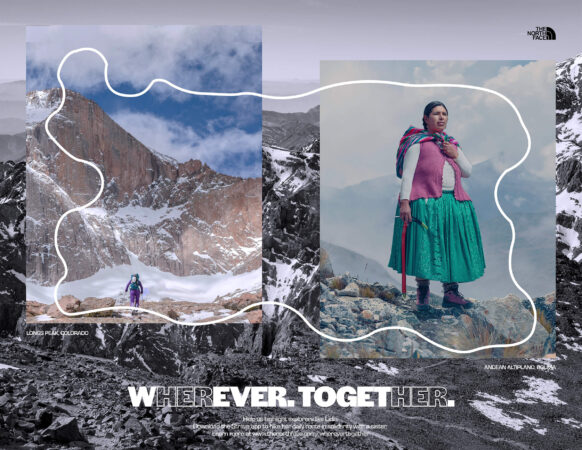Jessica Nuremberg, Co-Founder of SOUNDBytes sat down with The North Face’s global chief marketing officer, Sophie Bambuck. She provided a fascinating look at the company’s innovative marketing approach and commitment to making a positive impact on the world.
Our discussion revolved around The North Face’s mission to disrupt the outdoor industry for progress and inclusivity, its approach to marketing to both athletes and new entrants in the outdoor industry, and her thoughts on collaborations and sustainability.
WHAT INSPIRED YOU TO TAKE THE ROLE OF CMO OF THE NORTH FACE?
Bambuck: My entire career has been in marketing, working globally, regionally, and locally. I respect and value the brand of The North Face. It has always been part of my radar and my life. I am an avid skier, and it has always been there with me from a very early age. As a marketer, it was an incredible opportunity to be able to work for a global brand that everybody has some sort of opinion about, mostly positive, and has endured a fair amount of ups and downs.
I am at a place in my life where I just want to have fun. I wanted to be able to work on a great brand and have a positive impact on the world. You choose to use your power. Every day, you make a decision. Right now, my choice is to apply it to this amazing brand and team. It is also one of the rare places where you can still do branding. I feel a lot of companies have forgotten what it is to do emotional storytelling and brand building, and The North Face gives me a platform to do just that.

An ad from The North Face “Whenever. Together” campaign
CAN YOU SHED SOME LIGHT ON YOUR PERSPECTIVE ON THE NORTH FACE AND ITS
MISSION?
Bambuck: When I joined The North Face, not just the marketing team but the entire organization was hungry for a little bit of a sharper definition as to what the brand was and where it was headed. Our team worked together to rewrite it, and it’s been an exciting process.
I highly encourage everybody to at least at some point have the experience to work on the mission, values, or purpose of their organization.
We are here to make sure people have the best gear to be able to perform outdoors, and we also want to make sure that we are enabling them to find the incredible, not just in nature but also in themselves.
Our mission and our purpose are really the anchors and filters for everything that we do as an organization, whether it is product creation or a one-on-one relationship with a consumer.
“PUSHING AN INDUSTRY FORWARD”—WHAT DOES THAT MEAN FOR YOUR BRAND AND HOW HAVE YOU BEEN DOING THAT ON A DAY-TO-DAY BASIS, BOTH INTERNALLY AS WELL AS WITH YOUR CONSUMERS?
Bambuck: It is a lofty goal, “pushing an industry forward.” Just like how Airbnb revolutionized the hotel industry and Tesla changed the way we think about purchasing a car, I think we have a responsibility to disrupt the outdoors.
It is taking the accepted way of doing things and disrupting it for the sake of progress. We must change the insular nature of the industry and be more inclusive, making it more representative of the actual people who are practicing the sports.
HOW ARE YOU APPLYING THE KNOWLEDGE THAT NEEDS TO SHIFT FROM B2C IN YOUR
MARKETING EFFORTS?
Bambuck: First of all, there are a lot of efforts that are not consumer-facing. From a more public-facing standpoint, we launched the Explore Fund and the Explore Fund Council where we have a fund that goes out to outdoor communities helping underprivileged youth get out to enjoy the outdoors. People need to know that it’s actually accessible and available to them.
We have a very robust athlete team, and they are the best of the best in their activities. They are The North Face athletes. The reality, though, is in the outdoor industry, you usually have connections in order to become a top athlete. When you are the daughter of somebody who is climbing a rock every day, you are bound to eventually want to climb, and you are most likely going to be really good at it. And that is what happens.
Our Athlete Development Program allows us to extend what we give our athletes and opportunities to people who do not have that connection. We landed our first cohort of 17 athletes this year. They are brilliant people. They are young. They are energetic. They come from everywhere. They have never had access to products, guidance, coaches, mentorship, or business advice. It is really about the things that you do that have an impact on the community. That’s how you make the difference.
WHAT DOES THE RELATIONSHIP BETWEEN MARKETING AND PRODUCT LOOK LIKE AT
THE NORTH FACE?
Bambuck: I have been in the retail apparel and footwear world for my whole career and this is the closest relationship I have ever had with a product team, and it’s essential. We spend a lot of time with our athletes and think about what innovations are going to matter in the future.
We are based in Denver and we have a lot of mountains, where we have access to top athletes, giving us access to in-depth insights that allow us to figure out what they need, from a product, technical, to literally life-or-death conversation sometimes: “Hey, if you build that rope too long, I might trip and fall.”
Too often, a product is built and then handed off to a marketing team that then has to figure out how to market it. I have been there and done that. It is hard. Sometimes you are handed something and you think, “How am I going to tell that story?”
Most of the products you see on the lifestyle side come from sharp product benefits or innovation insights. Then, we scale to make sure that we are catering to different mindsets.

A headshot of Sophie Bambruck
HOW DO YOU THINK ABOUT MARKETING TO THE ATHLETE VERSUS OTHER CUSTOMER
SEGMENTS?
Bambuck: There is a difference between living on the edges and living in the middle. We cannot cater to the lowest common denominator. We have to cater to aspiration or progression and then figure out how that is going to translate to a more accessible group of consumers. But we have to start with a sharp point.
There are all types of athletes. I mentioned the guys that are accomplishing fantastic things, but we also have athletes that are out there every weekend skiing and snowboarding, and we are also talking to that group as well.
It is extremely important for us to understand people who are not necessarily wanting to podium at UTMB [the Ultra-Trail du Mont-Blanc ultramarathon], but maybe they are looking to actually improve their performance. We want to make sure that we are there for them and still serve them from a product standpoint.
We have an iconic product. Icons are also not decided by an organization. You do not decide to make icons. You can hope that your product becomes iconic. Consumers decide if something becomes an icon. The Nuptse jacket that everybody has seen has become emblematic.
We make great products that consumers decide are the right thing for them, and they make the decision to (1) make them an icon, and (2) make them culturally relevant.
Do I spend a lot of time trying to figure out how to be relevant culturally? Yes, of course! But first, let us make sure we have great tech, great innovation, and a great product, because we cannot do that without the first part, without the athlete inside, and without serving society and an audience in the right way.
HOW ARE YOU LOOKING AT YOUR MARKETING EFFORTS FOR THE NEXT GENERATION?
Bambuck: We are definitely putting a lot of effort into helping new people, whether they are new to The North Face or new to the outdoors, understand that The North Face has the right solution for them. That is one big undertaking. Of course, some people are new because they are young, and some people are new just because they have never considered it before. We have to target those two segments with different messaging and in a relevant way.
We also recognize that access is not the same everywhere, and we have to provide solutions.
Acknowledging is something we can all do. We can all say, “Oh, it’s unfair.” What are we doing about it? We try to do more messaging to get a younger generation into the brand because we are providing a solution to a real problem, a real societal problem, and it is not a new problem, but is amplified right now. I do think that users are expecting more from brands, expecting them to be almost human, personal, apologize, and be real.
We have to show emotion. We have not always shown emotion. We have been very aspirational and beautiful, but not always an emotional brand. We are changing the tone and a little bit of our narrative to make sure that we are relevant to that audience.
HOW DOES YOUR TEAM APPROACH COLLABORATIONS?
Bambuck: We are approached all the time, and we are continuing to build our strategy and guardrails now.
First and foremost they have to pass the basic good guy filter. The idea is to work with partners who live the same life and have the same ambition. Ultimately, it is about helping and putting things out there that are positive and have good intent.
When we actually look at partners, what is it that they do that we cannot do? Ideally, we could learn from each other and vice versa. How we can help that brand, that person, and that retailer to be able to come up with something greater and really amplify what we are trying to do. We have a lot of criteria around sustainability and behaviors, and who we work with.
THE NORTH FACE HAS A LONG HISTORY OF SUPPORTING SUSTAINABILITY AND ENVIRONMENTAL CAUSES. HOW DO THOSE VALUES SHOW UP IN YOUR MARKETING EFFORTS AND PUSH THE INDUSTRY FORWARD?
Bambuck: Not enough is my honest answer. The reason I say not enough is that making sustainability sexy is really hard.I firmly believe that sustainability for consumers is a reason to love, not a reason to buy, and so you create affinity for your brand by having a sustainability message. It is a very delicate balance of how far you go on sustainability, knowing that you might not see a return but you might see a long-term connection to your brand because both are extremely valuable and valid. I would love for us to be able to have a sustainability platform 365 days a year because it is so embedded in the decisions we make every day.
SOUNDBytes is a marketing collective bringing best-in-class marketers together to propel collaboration, innovation, and deal-making, via a monthly digital event series featuring a diverse range of C-Suite speakers across Fortune 500 brands. Run by Michelle Edgar and Jessica Nuremberg, two marketing and media industry veterans, SOUNDBytes’ mission is to help brands and marketers create authentic connections to help propel business objectives into the future. For more information visit: www.soundbytescollective.com














































